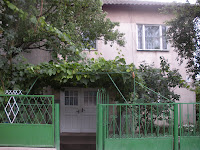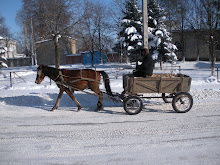Some pretty cool things went down last week that I didn’t get an opportunity to share yet….
...we visited a current community and organizational development volunteer in a beautiful raion (district) that borders Romania. Guess what? When you look across the river, Romania looks just like Moldova! This volunteer works with the local youth center that is operated by a public-private partnership. Right now, summer camps are in full session and this center has 10 consecutive rounds of kids (140 at a time) for five nights each. If I was a kid in Moldova this would be the camp I would want to go to…field trips, an above ground pool, huge playfield, indoor plumbing, gym, dance studio, etc. I have no misconceptions that I will be placed with a site so quite developed. It seems most volunteers have a nugget of advice for us, and this volunteers is particularly provocative for me. She said to go to work every day, be consistent even if all you do is go and work on Romanian homework. And she agreed with most volunteers that it really does take a year to finally feel integrated and useful. For her, she said it happened instantly, it was like she woke up one morning and said, I love my work! Although, I’m going to do my best to shorten that year by a few months, check back here next August and see how it’s going.

…we visited a local artist in our village. He makes beautiful pottery and his wife paints it. The clay even comes from our village. Some of his things sell in Moldova, but most go abroad. He was in exhibitions in Venice and Romania. He actually considers himself a musician by trade, but does the pottery to make a living. Seems the term starving artist is universally understood.
…we visited the museo (museum) in our village. It’s pretty small and run by just one man (his son was the founder of the museo, but died in an accident in 2002), but it really hel[ped us see what is important in the culture of our community. There were lots of old tools, equipment for spinning wool, and a wine press. In another room traditional clothing hung on the wall, it very much resembled the costumes worn by the Peace Corps Moldova staff on our first day of training. The most impressive room to me was one dedicated to WWII vets from our village. The walls are filled with their pictures, their helmets and weapons are on display, and two items resembling torpedoes are propped up in the corner (no Smithsonian style glass, security cameras, or lasers here!)
…I ate a new kind of soup! Our family friend was over the other night and she made a soup from beets, potatoes (like all soup), carrots, onion, garlic, dill, and rosemary. All of that was fresh out of our garden, and the beets turned everything a deep purple color that was just as appealing to the stomach in my eyes as the actual one in my body. Haha. I would definitely attempt a recreation of that. I’m hoping to cook more of these foods as time goes on.
…I made compote! Compote literally translates to boiled fruit juice. Basically, here’s what we did (as a collective family, but some definitely cooked more and some definitely picked more fruit): we picked bucket after bucket of visine. These bright red, sour cherries, literally fall off the trees. Then we washed and pitted them (I actually was at school when most part of this took place). Then we pout a huge pot of them on the stove with water, and a coffee mug of sugar for every 3 liter jar we made (a grand total of 150 liters has to be made for the year because our family is “MAAAARRRREEEE”). Once it boils, my host mom says a short prayer, then we start filling the jars and secure the boiled lids with this device that is literally the opposite of a can opener—it’s a closer—but looks very similar. We’ve also eaten sweetened visine as a dessert, and I’ve had raspberry compote from last year. The best part is that when you’re done drinking the juice, you get to eat the fruit from the bottom! Amazing!
…I’ve attempted to set the record straight. When new events happen, I get a few questions about America. It rained one day, “does it do this in America?” We were essentially canning fruit, “do Americans do this?” Fresh bread was made, “It’s not from a store like in America, you know.” We picked raspberries, “are these in America?” These questions are great because it gives me an opportunity to talk about the diversity of our country. In the Soviet schools, children learned that another continent existed, but the only detail my language teacher remembered ever seeing about the U.S.A. in school was a political cartoon of a fat, happy, greedy man. I really appreciate these little moments where I don’t have to do anything but explain that we are all the same, have the same worries, and equally enjoy happiness provided in the form of fresh fruit.
…the museo caretaker came to our class to talk about Moldovan history. His story is intriguing because he was already studying at the university when the Soviet Union took over. He was a history teacher in our village during the Soviet era. Between he and our language teachers input, my understanding of Moldova’s roots is becoming more concrete. Some the nuggets this man shared with us were about the deportations in the 1940s. Apparently, many people were taken from our village and sent to Serbia for speaking poorly about communism. As an intellectual himself, he said he had to be very careful. If you were deported, they sent you in wagons. They would come for you in the middle of the night, and you would stand in this packed wagon for days. Then, you would have to remain in Serbia. It is the darkest point in Moldovan history.
The deportations allowed the Soviets to bring more Russian people (and therefore, influence) to Moldova. This includes the introduction of the crylic alphabet. Crylic is the alphabet used for Russian, not latin languages. However, the Soviets decided Romanian could still be used, though only with a crylic alphabet. My language teachers said they were in college when the Soviet Union collapsed. One night there was a huge rally in the center of the capital, near the statue of Stefan Cel Mare (Stephen the Great), and the new establishment announced that the latin alphabet would be used again. My teachers said they literally learned their new alphabet in that one single night. You had to!
As we discussed the positive things that came to Moldova under the Soviet Union, this old man told us about the 1980 Moscow Olympics. The Olympic torch came through our village! I think that would have been a sight! There would have been so many more people in the village than there are now and a huge celebration on Stefan Cel Mare (Stephen the Great Street…aka main street of every town…I’ll tell more about him later). Our language teachers said the primary difference between Soviet Moldova and current day Moldova is that people truly believed they lived and worked in the best country on earth. Now, they all just grow up looking for ways to get out and make money abroad. It’s very disappointing to my teacher.

…and finally, we attended the Independence Day celebration sponsored by the embassy’s alumni association and the American Chamber of Commerce. They served “American Style Food” and the event was sponsored by McDonalds and Mary Kay. Go figure?! It was great to have a night out and see our fellow trainees as well as meet some of the current volunteers we have not yet had the chance to meet. Happy birthday U.S. of A!




































